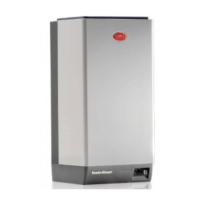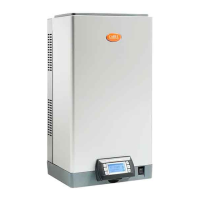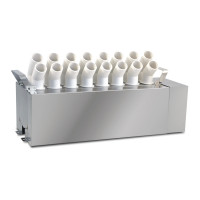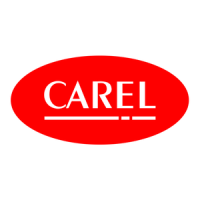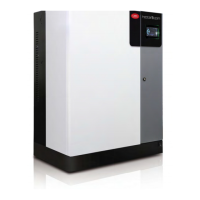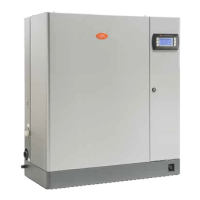45
ENG
“UE BASIC” +03U0042EN - rel. 1.3 - 10 May 2013
12. ADVANCED FUNCTIONS
12.1 Operating principle
Immersed electrode humidifi ers manufacture steam by boiling the water
contained inside the cylinder. The heat required to boil the water is
produced by passing an electrical current through the cylinder. This is done
by applying a voltage to the electrodes immersed in the water.
Initially, when the cylinder is new or has just been cleaned, the current
depends almost exclusively on the type of supply water: the more salts in the
water, the higher the current, and the required steam production is achieved
quicker. Over time the salt deposits in the cylinder increase (these do not
evaporate with the water), helping achieve the rated production. In steady
operation, the level of production required is maintained automatically by
controlling the current input, adjusting the level of water in the cylinder.
The salts that deposit over time cause the progressive depletion of the
cylinder. To avoid excessive accumulation, the humidifi er automatically
drains and replenishes a certain quantity of water at set intervals.
12.2 Control principles
ON/OFF control
The action is all or nothing, activated by an external contact that consequently
determines the control set point and diff erential.
The external contact may be a humidistat, whose status determines the
operation of the humidifi er:
• contact closed: the humidifi er produces steam if the remote ON/OFF
contact is also closed;
• contact open: the production of steam ends.
Proportional control
The production of steam is proportional to the value of a signal “Y” from an
external device. The type of signal can be selected between the following
standards: 0 to 10 Vdc, 2 to 10 Vdc, 0 to 20 mA, 4 to 20 mA.
The entire range is indicated as the proportional band. The maximum
production of the humidifi er, corresponding to the value maximum of
the external signal, can be set from 20% to 100% of the rated value of the
humidifi er (parameter P0).
The minimum production has an activation hysteresis, hy, equal to 5% of the
proportional band of the external signal “Y”.
ONOFF
hy
hy
hy
Banda Proporzionale / Proportional Band
P0
Pmin =
20%
Y
%
Produzione di vapore
Steam production
Fig. 12.a
12.3 Supply water conductivity
Conductivity measurement and alarms
The conductivity of the supply water is measured by the conductivity meter
when the fi ll solenoid valve is opened.
Two programmable alarm thresholds are available:
• b5: warning threshold (signal only without activating the alarm relay,
automatic reset when the condition is no longer present);
• b6: alarm threshold (unit shutdown with activation of the alarm relay).
The alarm is activated when the reading exceeds one of the two thresholds
continuously for 60 minutes, or alternatively instantly if the value read is 3
times higher than the threshold.
To disable the alarm signal, simply set the thresholds above the maximum
value of the reading.
12.4 Automatic draining
The humidifi er automatically drains and replaces some of the water
contained in the cylinder, to prevent an excessive concentration of salts
following the evaporation process.
The drain pump is opened for a set time whenever the conductivity exceeds
the maximum limit; this situation is measured indirectly by evaluating the
evaporation speed.
During the automatic draining phase, the electrodes are off , so as to prevent
the drain water from carrying current (the display shows “dr”).
Drain due to excess foam
With certain types of supply water, foam may form during the production
of steam just above the water. This situation must be resolved, as it may
cause water to be released together with the steam. For this purpose, two
electrodes are fi tted on the top of the cylinder. When these electrodes
detect the presence of foam, the humidifi er activates a series of repeated
drain cycles. If the situation persists, the complete washing of the cylinder
is activated.
Drain due to inactivity
In humidifi er does not operate for an extended time (it remains on but does
not produce steam), the water in the cylinder is drained automatically, to
avoid stagnation and hygiene risks. The inactivity time is set using parameter
“bF” (default 3 days). The function can be disabled by setting parameter b1
( see paragraph 11.6).
Powered draining
When running an automatic drain cycle due to excessive salt, the electrodes
are not powered and the production of steam is thus reduced. To keep the
electrodes powered during the drain cycle set parameter b1 ( see paragraph
11.6).
Draining due to a signi cant reduction in the request for
production
In the event of a signifi cant reduction in the request for steam production, the
humidifi er, rather than wait for the level of water (and thus the production)
to decrease due to the eff ect of the production itself, performs a drain cycle.
The reduction in the request for steam production is considered signifi cant
if the current is 33% higher than that relating to the requested level. This
function can be disabled.
Set parameter b1 ( see paragraph 11.6)
Periodical drain
When using water rich in substances such as humus and lime, a periodical
drain cycle should be set for the cylinder to avoid accumulating residues.
To enable the periodical drain, set parameter b1 to 64. In this way, every
24 h the humidifi er will drain all the stagnant water in the cylinder, and
the display will show code “dP” (periodical drain). If the periodical drain is
enabled, the number of hours between two periodical drain cycles can be
set using parameter “bE”.
Note:
For the manual drain function, see chap. 6, for the mechanical drain see
paragraph 9.4.
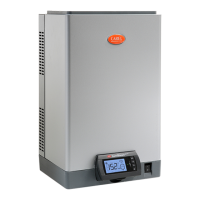
